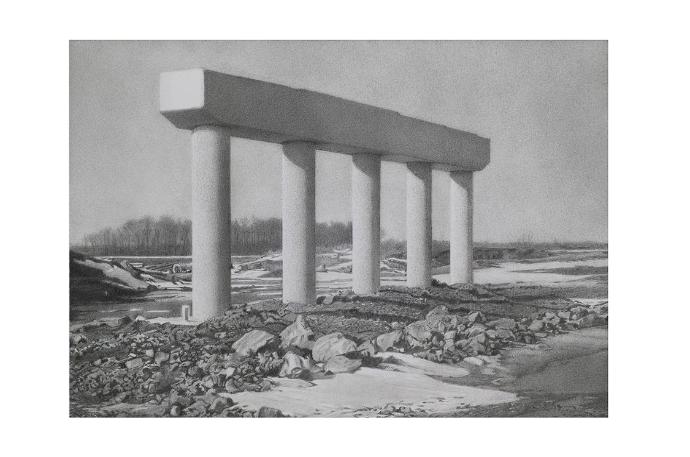| Exemplary Images Charles Kanwischer at Shaheen Contemporary and Modern Gallery Charles Kanwischer’s soft-focus graphite on panel drawings are like quiet, essentially harmonious visual static, humming around the shapes of remarkable things that everybody sees, but nobody particularly notices. Oversize concrete sewer pipes are lined up like objects in a cubist still life, or a massive piece of road grading equipment is seen, remarkably, to resemble a gigantic fetish object. Each discovery and condition of light emerges ontot he surface of the paper with its own, steady pulse. Flowering weeds and stalks of grass in “Thistle Field” are made up of tiny, sharp marks, catching at the eye like burrs or thorns. Monumental, generic architectural shapes in “US 24 Road Project – Support Columns,” or the calm Big Box-modern décor and furniture in the interior of a model home, based on a photo from a real estate brochure, pull the viewer’s attention into what is, one realizes, a curiously ideal world. Kanwischer’s technique absorbs the gaze like sunblock. First deflecting the impression that his roughly one foot square grisaille studies might be photographs, he goes on to twiddle the knobs of preconception, asking questions about functional hierarchies, observing quirky cultural continuities. He translates ex-urban scenes which, while typical of northeastern Ohio (born in Oklahoma, Kanwischer grew up near Chicago and is currently a resident of Waterville, Ohio), are also typical in a more general sense, as examples of contemporary infrastructure and home construction -- the latest derivations of eternal forms. One of the comforts Kanwischer offers is a sense of recognition: we have all been in these places, passed by these unremarkable scenes, quoted as if randomly from a daily world that might be encountered almost anywhere. Filtered through a fine sieve of observation, his images are winnowed in a way that hints at mysteries, wrapped, and in a way democratized, by a grid of laborious artistic process. Each presents a concise argument for the interest inherent in commonplace sights, especially the sort of low-key, transitional landscape events that occur between suburb and farmland. Familiar drive-by “scenery,” like a low mound of fill dirt, or a mountain of construction debris, or a half-built house patterned from foundation to roof line with the Tyvek company logo, are the subjects here – things that are too ordinary even to be “humble,” and too functional, too lacking in intimate association to register as objects with a significant aesthetic dimension – a dimension that Kanwischer nevertheless manages, unerringly, to locate. Kanwischer’s renderings suggest more pessimistic truths, as well: the constant falling away of form from spirit, and the ruin inherent in all new beginnings. His drawings are like illustrations, fetched somehow from a future time – exemplary images showing a civilizing process of landscape transformation that devolves toward sterile perfection, yet evokes an idyllic classical era. Kanwischer thus invites the past into the present, and not necessarily for purposes of comparison. His “Mound” is a barrow where ancient responses to the land are buried, his “Culvert” an Elysian tarn; nymphs taunt beyond its flaring precast concrete wing walls. These are not romantic visions; it’s not that Eden or innocence can be found by squinting along the length of a pencil, but that the currents of time move through the forms of usage, as inescapable and eternal as weather. -- Douglas Max Utter Charles Kanwischer 6/18/10 – 7/30/10 Shaheen Modern and Contemporary Art 740 West Superior Avenue, Cleveland, OH, Suite 101 216.830.8888 |

Support Columns 2010 Charles Kanwischer graphite on paper